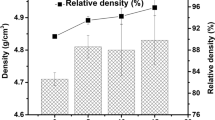Abstract
The correlation between temperature treatment conditions and the ratio of components in nanostructured fibrous powders with a composition of ZrO2-Y2O3-Al2O3 and their porous crystal structure and physicochemical properties is studied. The dependences of the ratio between zirconia tetragonal and monoclynic phases on the treatment temperature and the alumina content are found to have a nonmonotonic character. The growth of zirconia crystallite size is suppressed by introduced nanocrystalline alumina in a temperature range of 600–1200°C, which is caused by the processes of ternary solid solution formation. The bulk and picnometric density values of materials are proportional to the temperature of heat treatment. The temperature dependence of the specific surface and the size of oxide grain particles has an inversely proportional character. With increasing alumina content in the powders, the specific surface increases, while the picnometric and bulk densities decrease.
Similar content being viewed by others
References
V. S. Bakunov and E. S. Lukin, Steklo Keram., No. 2, 3 (2008).
E. Dujardin and S. Mann, Adv. Mater. 14, 775 (2002).
I. N. Ermolenko, Spectroscopy in the Chemistry of Oxidized Celluloses (Akad. Nauk BSSR, Minsk, 1959) [in Russian].
W. B. Blumenthal, Zirconium (Van Nostrand, Princeton, NJ, 1958; Inostr. Liter., Moscow, 1963).
T. M. Ulyanova and N. P. Krut’ko, J. Nanotechnol. 3, 47 (2006).
L. S. Zevin and L. L. Zav’yalova, Quantitative X-Ray Phase Analysis (Nedra, Moscow, 1974) [in Russian].
I. N. Ermolenko, T. M. Ul’yanova, P. A. Vityaz’, and I. L. Fedorova, Fiber High-Temperature Ceramic Materials (Navuka Tekhn., Minsk, 1991) [in Russian].
Ya. S. Umanskii, X-Ray Analysis of Metals and Semiconductors (Metallurgiya, Moscow, 1969) [in Russian].
A. I. Gusev, Nanomaterials, Nanostructures, Nanotechnologies (Fizmatlit, Moscow, 2007) [in Russian].
V. N. Pavlikov, V. A. Yurchenko, V. E. Pepelyaev, and Z. A. Zaitseva, Steklo Keram., No. 3, 18 (1989).
S. Gregg and K. Sing, Adsorption, Surface Area and Porosity (Academic Press, London, 1982; Mir, Moscow, 1984).
T. M. Ulyanova, L. V. Titova, S. V. Medichenko, et al., Crystallogr. Rep. 51, 144 (2006).
Phase Diagrams of Refractory Oxide Systems: Handbook, Ed. by F. Ya. Galakhov (Nauka, Leningrad, 1985), No. 1, pt. 1, p. 310 [in Russian].
T. M. Ul’yanova, L. V. Titova, N. P. Krut’ko, and E. M. Zub, Poverkhnost’, No. 7, 49 (2002).
Author information
Authors and Affiliations
Additional information
Original Russian Text © T.M. Ul’yanova, N.P. Krut’ko, L.V. Titova, Yu.G. Zonov, 2010, published in Poverkhnost’. Rentgenovskie, Sinkhrotronnye i Neitronnye Issledovaniya, No. 7, pp. 70–76.
Rights and permissions
About this article
Cite this article
Ul’yanova, T.M., Krut’ko, N.P., Titova, L.V. et al. A study of the structure and properties of nanostructured ZrO2-Y2O3-Al2O3 composite powders. J. Surf. Investig. 4, 603–608 (2010). https://doi.org/10.1134/S1027451010040117
Received:
Published:
Issue Date:
DOI: https://doi.org/10.1134/S1027451010040117




